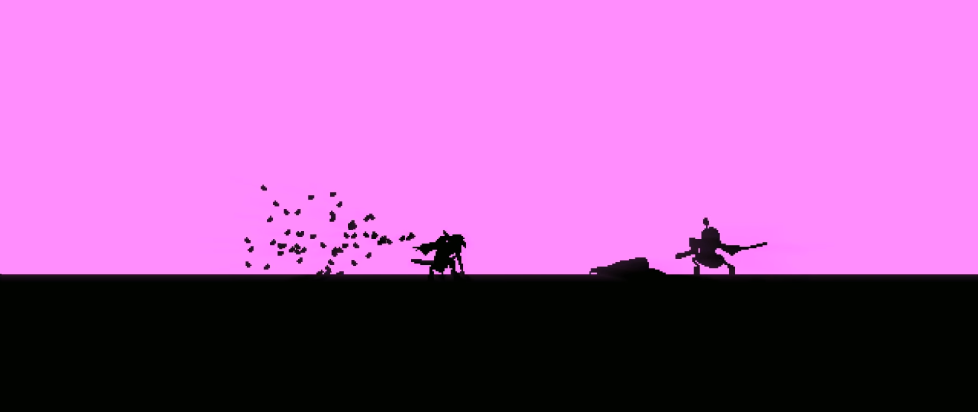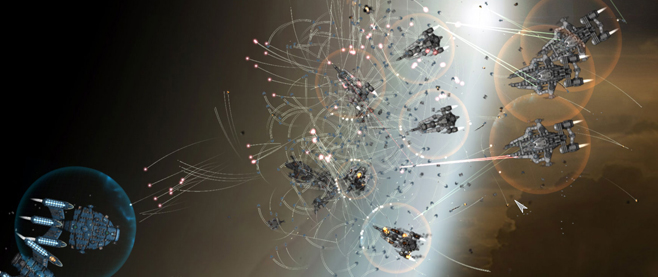
Katana ZERO and the Mask of Death
Each day in Katana ZERO is a panic of violence. Your mission, your handler tells you, is simple; eliminate your targets and anyone who gets in the way. But your drinking shields your mind from guilt, your nightmares haunt you with the people you’ve killed, your addiction takes the meaning from your life. And in your dreams, two masked men haunt you – the ghosts of Comedy and Tragedy, wearing metallic masks and white lab coats, warning of a choice you will have to make between life and death. Taking a breath, Katana ZERO’s trance-like violence lets you push these thoughts below the surface, but in moments of calm, they surround you.
You keep killing, but the masked men refuse to remain silent. In Katana ZERO’s seventh level, Chinatown, they stop the pulsing bloodshed and electronic music to tell you that now is the time, and the choice is not as easy as it seems. If you choose life, you are gently returned to an overwhelming swarm of military police, Tragedy’s last words to you a wish that you find peace in death. You have to make the other choice. Rejecting life, you are given the silver mask of death – the police fall to the ground in agony and Tragedy curses you and your fate. “One life for another,” Comedy teases.
This is how it has to be. This choice cruelly shows you your only opportunity to escape your descent, and forces you to choose to reject it. I can’t praise it enough, but praise is all I can give. I set out to write this article because I wanted to talk about my personal connection with Katana ZERO, but I know I can’t express that through this scene – somehow it doesn’t feel like mine.
Katana ZERO is a story about addiction. The game centers on a drug called chronos, part of a secret military project to make super soldiers who can see the future. You are one of these super soldiers, and though the war has been over for decades, you can’t leave chronos. But beyond that, Katana ZERO itself is addicted to chronos – using its time-slowing power is almost necessary to beat most levels, and every character and plot point ties into it. It’s hard for me to relate to this since I’ve never suffered from addiction, but then I see how chronos haunts your dreams, how it weighs on every interaction you have with the world, and I realize I can understand it more than I think.

In your dreams, you see children playing inside a hut. A man rushes in, shouting for them to hide before a masked figure bursts through the door and shoots him. And this is chronos too, a half-lost memory of seeing the future. But then your handler takes the role of psychiatrist; he says they’re nothing, tells you about your next target, and gives you more chronos. Addiction in Katana ZERO means manipulation, self-doubt, obsession, paranoia, sleeplessness – suddenly your character seems powerfully human. The nuances of a fictional drug become a language that Katana ZERO speaks through, and a language I can learn to understand; I start to notice chronos in every corner of the game, and they seem human too.
Chronos and addiction are important to Katana ZERO, but they aren’t the only way the game communicates. It’s also a story about descent, about violence, about destiny, about too many other things to fit in this article. Playing and replaying, I feel the main character’s humanity transform him – he becomes cold and detached, but at the same time sensitive and vulnerable. The game doesn’t make you acknowledge this, and you can play without really engaging with its story, but I think reflecting on your own life through the story is something almost unavoidable. In these moments, and in these slow changes, you can sense humanity.
This is why I can’t write about the masked men’s choice. My connection to Katana ZERO is something I shaped; I had to reach out and find the feelings I now see in the game’s story. The relationship that I made with it relies as much on my own thoughts and feelings as it does on the game’s outstanding writing. Yet, the masked men’s choice feels like the exception – the game spoke almost directly to me, giving me a choice and telling me how to feel. I don’t want to diminish it as a powerful scene, both in the sense of doom it brings and in the way it transforms the story – it’s just not part of the relationship I built with Katana ZERO. The feelings I’ll remember most, the parts of Katana ZERO I’ll still talk about far from now, are the connections that I had a hand in creating.
———
John Sangster is a game design student in Toronto. He loves talking about games and how they communicate. Find him on Twitter, Instagram and Bluesky as @metajarra and at metajarra.itch.io.





